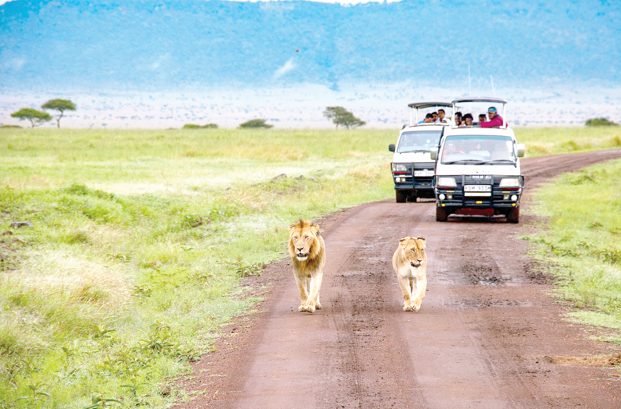Kenya’s tourism boom should spur youth jobs

The tourism sector demonstrated remarkable resilience and growth in 2024, driven by strategic interventions such as the Electronic Travel Authorisation (ETA) system and aggressive marketing campaigns.
As Kenya Airways posted positive results in its annual report, posting a profit for the first time in 11 years, international tourist arrivals surged to 2.4 million—a 14.6 per cent increase from the previous year—the sector generated an impressive Sh452.2 billion in earnings, up 19.79 per cent from 2023.
Tourism and Wildlife Cabinet Secretary Rebecca Miano attributed this positive trajectory to improved accessibility and enhanced connectivity, bolstered by the entry of new scheduled airlines such as AirAsia, FlyDubai, and the re-launch of Brussels Airlines.
Speaking at a Mombasa hotel during her appearance before the Senate Standing Committee on Trade, Industrialization, and Tourism, Miano said that this surge in arrivals translated into increased tourism earnings, rising from Sh377.49 billion in 2023 to Sh452.2 billion in 2024.
Strong performance in 2024
Meanwhile, domestic tourism also showed strong performance, with bed occupancy increasing by 12 per cent, from 4.6 million to 5.2 million.
“Kenya’s tourism sector has demonstrated resilience and remarkable growth in 2024,” Miano stated. “At the State Department of Tourism, we are implementing strategic programs aimed at attracting 5 million visitors by 2027.” Looking ahead, the government aims to increase tourism earnings to Sh988.2 billion by 2027.
To sustain this upward trajectory, Kenya must, however, continue enhancing air travel infrastructure by attracting more international carriers and expanding airport facilities. Upgrading regional airports to accommodate direct international flights will unlock new opportunities in less-explored tourism circuits, ensuring a more even distribution of visitors across the country.
By mapping and developing niche experiences such as cultural tourism, eco-tourism, and adventure tourism, the country can attract a broader range of travelers. The vibrant cultural heritage of the Maasai, Samburu, and Turkana communities presents an untapped opportunity for immersive experiences. Similarly, promoting adventure tourism activities like hiking in the Aberdares, paragliding in Kerio Valley, and deep-sea diving along the coast can appeal to thrill-seekers.
In today’s digital age, leveraging technology is essential for effective marketing and promotion. The government’s adoption of the ETA system has simplified the visa process, making Kenya more accessible to international travelers. However, further digital transformation is needed. Enhanced use of artificial intelligence (AI) and big data analytics can help tailor marketing strategies to specific demographics, ensuring targeted promotions in both traditional and emerging source markets. Additionally, expanding Kenya’s presence on digital travel platforms and social media can boost engagement and attract more visitors.
A stable policy environment is critical for sustainable tourism growth. The government must ensure that regulatory frameworks encourage investment, protect natural resources, and uphold high service standards.
Need for more collaboration
Streamlining licensing procedures for tourism enterprises, strengthening environmental conservation policies, and enforcing strict quality control measures will enhance the sector’s credibility. Furthermore, continued collaboration with county governments will ensure a cohesive approach to tourism development across different regions.
“To sustain and accelerate this growth, we are fostering strong collaborations between national and county governments, as well as industry players, to ensure Kenya remains a top travel destination,” Miano says.
With the concerted efforts, CS Miano believes Kenya’s tourism industry is well on its way to achieving record-breaking numbers, solidifying its status as a premier global destination.
While international tourism is a significant revenue generator, domestic tourism remains a key pillar of resilience. The 12 per cent increase in domestic bed occupancy in 2024 shows a growing interest among Kenyan travelers. To sustain this trend, the government should introduce incentives such as discounted park entry fees for residents and affordable holiday packages tailored for Kenyan families. Encouraging schools and institutions to incorporate educational tours into their curricula can also foster a culture of domestic travel from an early age.
Youth involvement key
Tourism is, however, a labour-intensive industry, and empowering young people with relevant skills will be instrumental in driving the sector forward. The government’s commitment to youth involvement should be realized through vocational training programmes in hospitality, tour guiding, and digital marketing.
Establishing incubation hubs for tourism startups will also provide young entrepreneurs with resources to develop innovative tourism solutions.
With a clear goal of attracting 5 million visitors and increasing tourism earnings to Sh988.2 billion by 2027, Kenya’s tourism industry stands at a pivotal moment. Strategic investments in infrastructure, tourism diversification, marketing innovation, and policy reforms will be crucial in sustaining growth.
By fostering collaboration, embracing technology, and strengthening governance, Kenya can unlock the full potential of its tourism sector, ensuring it remains a vital pillar of the economy while delivering unforgettable experiences to travelers.















